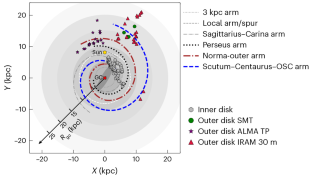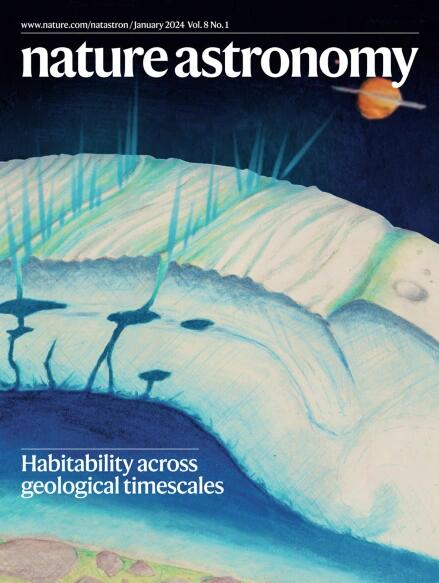Inadequate turbulent support in low-metallicity molecular clouds
IF 14.3
1区 物理与天体物理
Q1 ASTRONOMY & ASTROPHYSICS
引用次数: 0
Abstract
The dynamic properties of molecular clouds are set by the interplay of their self-gravity, turbulence, external pressure and magnetic fields. Extended surveys of Galactic molecular clouds typically find that their kinetic energy (Ek) counterbalances their self-gravitational energy (Eg), setting their virial parameter αvir = 2Ek/∣Eg∣ ≈ 1. However, past studies either have been biased by the use of optically thick lines or have been limited within the solar neighbourhood and the inner Galaxy (Galactocentric radius Rgc < Rgc,⊙ ≈ 8 kpc). Here we present sensitive mapping observations of optically thin 13CO lines towards molecular clouds in the low-metallicity Galactic outer disk (Rgc ~ 9–24 kpc). By combining archival data from the inner Galaxy and four nearby metal-poor dwarf galaxies, we reveal a systematic trend of αvir, which declines from supervirial dynamic states in metal-rich clouds to extremely subvirial dynamic states in metal-poor clouds. In these metal-poor environments, turbulence alone is insufficient to counterbalance the self-gravity of a cloud. A cloud-volumetric magnetic field may replace turbulence as the dominant cloud-supporting mechanism in low-metallicity conditions, for example, the outermost galactic disks, dwarf galaxies and galaxies in the early Universe, which would then inevitably impact the initial conditions for star formation in such environments. Low-metallicity molecular clouds in the Milky Way and nearby galaxies exhibit a strong deficiency in turbulent support against their self-gravity, suggesting that the magnetic field may play a dominant role in supporting clouds under such conditions.


低金属丰度分子云湍流支持不足
分子云的动态特性是由其自身重力、湍流、外部压力和磁场的相互作用决定的。对银河系分子云的扩展研究通常发现,它们的动能(Ek)抵消了它们的自引力能(Eg),使它们的维里参数αvir = 2Ek/∣Eg∣≈1。然而,过去的研究要么由于使用光学粗线而有偏差,要么被限制在太阳附近和内星系(星系中心半径Rgc <; Rgc,⊙≈8 kpc)。本文介绍了低金属丰度星系外盘(Rgc ~ 9-24 kpc)分子云的光学薄13CO谱线的灵敏测绘观测结果。结合银河系内部和附近4个缺金属矮星系的档案数据,揭示了αvir从富金属云的生存动态到贫金属云的极度生存动态的系统趋势。在这些缺乏金属的环境中,光靠湍流不足以抵消云的自重力。在低金属丰度条件下,例如在最外层的星系盘、矮星系和早期宇宙中的星系中,云体积磁场可能取代湍流,成为主要的云支持机制,这将不可避免地影响这种环境中恒星形成的初始条件。
本文章由计算机程序翻译,如有差异,请以英文原文为准。
求助全文
约1分钟内获得全文
求助全文
来源期刊

Nature Astronomy
Physics and Astronomy-Astronomy and Astrophysics
CiteScore
19.50
自引率
2.80%
发文量
252
期刊介绍:
Nature Astronomy, the oldest science, has played a significant role in the history of Nature. Throughout the years, pioneering discoveries such as the first quasar, exoplanet, and understanding of spiral nebulae have been reported in the journal. With the introduction of Nature Astronomy, the field now receives expanded coverage, welcoming research in astronomy, astrophysics, and planetary science. The primary objective is to encourage closer collaboration among researchers in these related areas.
Similar to other journals under the Nature brand, Nature Astronomy boasts a devoted team of professional editors, ensuring fairness and rigorous peer-review processes. The journal maintains high standards in copy-editing and production, ensuring timely publication and editorial independence.
In addition to original research, Nature Astronomy publishes a wide range of content, including Comments, Reviews, News and Views, Features, and Correspondence. This diverse collection covers various disciplines within astronomy and includes contributions from a diverse range of voices.
 求助内容:
求助内容: 应助结果提醒方式:
应助结果提醒方式:


